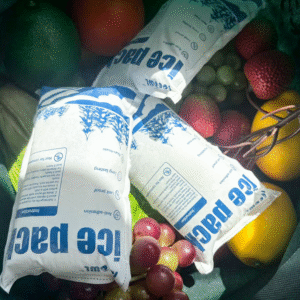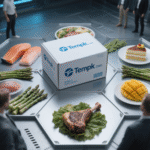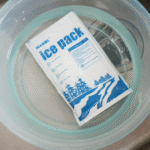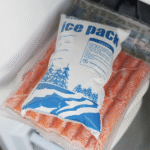كيفية استخدام حزمة ثلج جافة لشحن الطعام (2025)
تحديث: أغسطس 19, 2025
You want a علبة ثلج جاف لشحن المواد الغذائية that keeps products safe, متوافق, and cost‑effective. بعبارات بسيطة: use dry ice when you need ultracold, use hydrated “ice sheets” or PCM (phase‑change) panels for chilled or −20 °C lanes, and right‑size the coolant by time and insulation. Real dry ice requires venting and UN1845 labels; hydrated/PCM packs do not.
-
What a dry ice pack for shipping food really is (and when “dry ice sheets” aren’t CO₂)
-
How many dry ice packs for shipping food you need using fast rules and a calculator
-
How to pack a dry ice pack for shipping food step‑by‑step for 24–72 hours
-
ماذا 2025 shipping rules require للتسميات, airline limits, and postal guidance
-
When gel or PCM beats a dry ice pack for shipping food in real lanes
What is a dry ice pack for shipping food—and when is it not real dry ice?
إجابة قصيرة: Many “صفائح الجليد الجافة” are hydrated polymer ice blankets or PCM panels you freeze and reuse; هم كذلك لا CO₂ الصلبة. Real dry ice is carbon dioxide at −78.5 °C (.309.3 درجة فهرنهايت) that يتسامى إلى الغاز, so packages must vent and carry UN1845 علامات. Use hydrated/PCM for chilled or −20 °C holds; use real dry ice for ultracold or long frozen runs.
لماذا يهمك: Hydrated sheets and PCM are non‑hazmat and simplify training; real dry ice adds labeling, تنفيس, and booking details. For food safety, hold refrigerated items at ≤40 درجة فهرنهايت through delivery; use 0 °F for freezer targets.
Dry ice sheets vs. هلام ضد. PCM مقابل. الثلج الجاف الحقيقي (ما الذي يجب أن تختار?)
Hydrated “dry ice sheets” wrap products, freeze flat, and shine for 33-40 درجة فهرنهايت holds. حزم هلام are simple and reusable for chilled lanes. لوحات PCM (على سبيل المثال, ~5 °F or −20 °C) act like a “thermal battery,” bridging chilled↔frozen without hazmat. الثلج الجاف الحقيقي wins when “arrives rock‑solid frozen” is non‑negotiable or transit is 48–72 h+.
| المبرد | Typical Temp/Hold | وطن? | ماذا يعني لك |
|---|---|---|---|
| Hydrated “ice sheets” | ~10–32 °F for 24–48 h | لا | Flexible wrap for meal kits and short parcel. |
| حزم هلام | ~20–32 °F for 24–48 h | لا | تكلفة منخفضة, easy handling for 2–8 °C lanes. |
| لوحات PCM (≈5 °F/−20 °C) | Flat plateau at setpoint | لا | Frozen‑assist or −20 °C holds without DG. |
| الثلج الجاف الحقيقي (co₂) | .309.3 درجة فهرنهايت / −78.5 درجة مئوية | نعم | Best for ultracold/long frozen; تنفيس & Label UN1845. |
نصائح عملية يمكنك التقديم اليوم
-
Meal kits (48 ح): Line walls and top with hydrated sheets; add one 5 °F PCM brick against proteins for colder stability.
-
الحلويات المجمدة: مكان الجليد الجاف في الأعلى (مغسلة الهواء البارد) and add a thin sheet/PCM layer to protect surfaces; تنفيس الصندوق.
-
Hot routes: يضيف 25-50 ٪ more sheet/gel mass or upgrade insulation (على سبيل المثال, بطانات VIP).
حالة حقيقية: A bakery replaced all‑dry‑ice loads with two PCM bricks + three hydrated sheets for chilled SKUs and held 34–38 °F over 36 h, eliminating DG surcharges. Frozen SKUs kept a small dry‑ice topper for “rock‑solid” arrivals.
How many dry ice packs for shipping food do you need per day?
Fast rules that work:
-
الجليد الجاف (real CO₂): يخطط ~5–10 lb per 24 h per insulated box; increase for larger coolers, الجدران الرقيقة, أو الحرارة.
-
Hydrated sheets/gel (مبردة): عن 1 lb per cubic foot per 24 h to hold 33–40 °F; add 25–50% for hot lanes.
-
لوحات PCM: size by coverage and setpoint (على سبيل المثال, -20 درجة مئوية); fully precondition per vendor guidance.
Starting points you can copy:
-
25- كيو تي الشاحن: ~10 lb dry ice for 24 h, أو 2–3 sheets + 1 PCM لبريك لبرودة.
-
45- كيو تي الشاحن: 15–20 lb dry ice for 24 h, أو 4–5 sheets + 2 الطوب PCM لبرودة.
How to pack a dry ice pack for shipping food, خطوة بخطوة?
افعل هذا: hydrate or precondition → freeze solid → wrap → top‑load cold mass → seal (vent if using CO₂). Keep products pre‑chilled to ≤40 °F or pre‑frozen to 0 °F to prevent early temperature spikes.
-
Condition the coolant:
-
Hydrated sheets: soak mesh side, drain, و freeze flat 24 h.
-
بي سي إم: freeze to labeled setpoint (على سبيل المثال, -20 درجة مئوية) until fully solid.
-
-
Wrap the payload: line bottom and sides; fill all voids to stop warm air loops.
-
Add top layer: cold mass on top; vented lid if using real dry ice.
-
Close and label: إضافة مسجل البيانات, seal the shipper, apply marks if any CO₂ is used.
Do you really need gel/PCM instead of a dry ice pack for shipping food?
إذا كانت المواصفات الخاصة بك 2-8 درجة مئوية أو -20 درجة مئوية within 24–48 h, gel or PCM often hits the target with less handling and no hazmat. ل 48–72 h ultracold or “arrives rock‑solid," الثلج الجاف still rules. Many teams now run الهجينة: PCM around the product plus a small dry‑ice topper for worst‑case heat.
Is a dry ice pack for shipping food allowed by 2025 شركات النقل?
نعم, with specifics:
-
IATA DGR 66th (2025): علامة "الثلج الجاف/ثاني أكسيد الكربون, صلب", UN1845, و وزن صافي (كجم); يضمن تنفيس التغليف; استخدم 2025 قائمة التحقق من القبول when dry ice is the only DG.
-
Carrier notes (2025): FedEx/UPS follow IATA internationally and domestic rules; check their job aids for label sizes and same‑face placement with Class 9.
-
USPS (air mail): ≤5lb لكل قطعة, حاوية تنفيس, UN1845 on address side; international mail with dry ice is محظور.
-
Passenger flights: 2.5 كجم (5.5 رطل) per passenger per package, مطلوب موافقة شركة الطيران, package vented and marked. Gel/PCM packs may fly in carry‑on if الصلبة المجمدة at screening.
2025 trends for the dry ice pack for shipping food
ما الجديد هذا العام: clearer IATA labeling and صافي - كجم booking practices, wider use of PCM at −20 °C to reduce hazmat touchpoints, and steady reminders to hold refrigerated foods at ≤40 درجة فهرنهايت. عزل أفضل (على سبيل المثال, بطانات VIP) means less coolant mass on many lanes—good for cost and claims.
Latest advances at a glance
-
Checklist‑driven acceptance: fewer handoff surprises when UN1845 and net‑kg are correct.
-
Hybrid packouts: بي سي إم + sheets for chilled, dry‑ice topper for edge cases.
-
Workplace CO₂ awareness: 5,000 جزء في المليون TWA / 30,000 ppm STEL—ventilate staging areas.
نظرة السوق: Upgrading insulation often saves more than adding coolant. Validate each lane with سجلات البيانات and lock the SOP once performance is proven.
الأسئلة الشائعة: common questions about the dry ice pack for shipping food
س 1: Will a dry ice pack for shipping food keep items frozen for 2–3 days?
غالباً نعم with real dry ice sized at 5-10 رطل/24 ساعة, great insulation, and tight packing. For −20 °C spec, PCM can replace some or all dry ice.
Q2: Are hydrated “dry ice sheets” the same as a dry ice pack for shipping food?
لا. Hydrated sheets and PCM are not CO₂; they freeze and do not vent gas. Real dry ice is CO₂ and needs venting/labels.
س 3: How much hydrated sheet or gel do I need with my dry ice pack for shipping food?
ابدأ بالقرب من 1 lb per ft³ per day for chilled holds, then adjust after a pilot with a logger.
س 4: What temperatures should I target for safety when using a dry ice pack for shipping food?
Keep refrigerated foods at ≤40 درجة فهرنهايت نهاية إلى نهاية; keep frozen items at 0 ° f or below before packout.
ملخص & التوصيات
النقاط الرئيسية: اختر علبة ثلج جاف لشحن المواد الغذائية based on target temp and duration. يستخدم hydrated/PCM for chilled or −20 °C with no hazmat; يستخدم الثلج الجاف الحقيقي for ultracold or long frozen holds. ابدأ مع 1 lb/ft³/day for sheets/gel and 5-10 رطل/24 ساعة للثلج الجاف, ثم التحقق من صحة المسجل. ملصق UN1845 and vent whenever CO₂ is used.
الخطوات التالية (copy this plan):
-
Define your lane (درجة حرارة + ساعات). 2) Pick coolant (sheet/PCM vs. الثلج الجاف). 3) Use the sizing rules and run a pilot. 4) Standardize your SOP with photos and a checklist. Need a lane‑specific packout? Scroll to the CTA below.
حول Tempk
We design validated cold‑chain packouts that hit your temperature‑time targets at the lowest landed cost. مهندسينا المعيار hydrated sheets, هلام, بي سي إم, والجليد الجاف combinations, ثم قم بتقديم إجراءات التشغيل القياسية الواضحة, label templates, and training so your team ships confidently—year‑round. تحدث إلى أخصائي TEMPK for a free 15‑minute packout review.
























